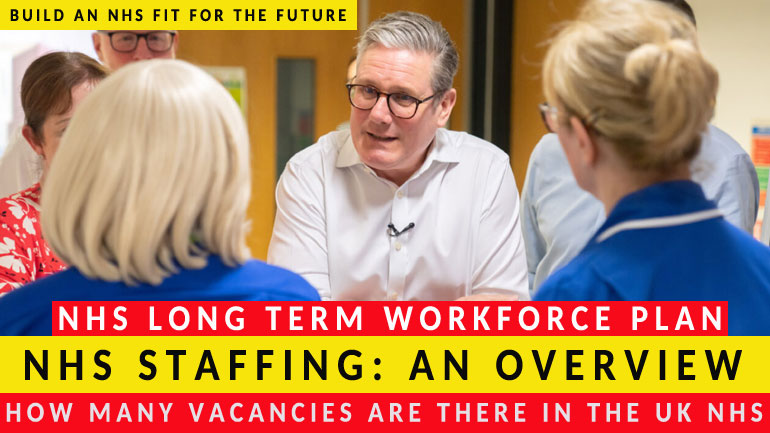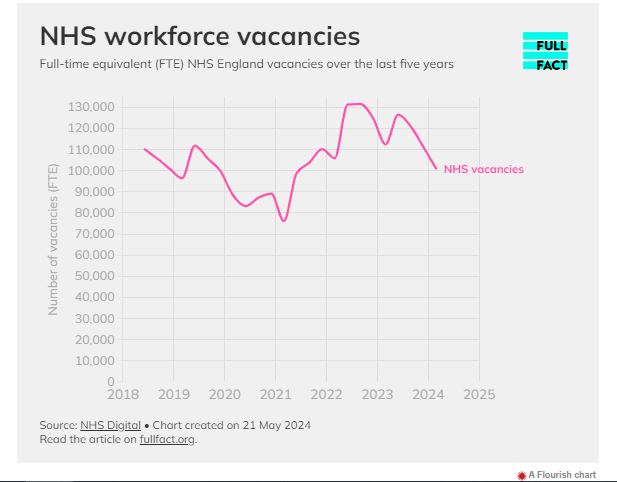UK NHS JOB VACANCIES: An overview
While the new administration in the UK is saying it will slow foreign recruitment, the reality is that the new government cannot stop foreign recruitment when there are still more than 100,000 uk NHS job vacancies. Labour government cannot reduce NHS waiting times without recruiting enough staff.
The Prime Minister, for example, informed Question Time viewers that the NHS employs “more doctors and nurses working” in it than it has in the past. Additionally, “more than a hundred thousand staff vacancies in England alone” are included in the Liberal Democrats’ manifesto.

These statements are accurate, but they don’t provide you with all the information you require. Here, we have covered the essentials.
This explainer is one in a series of “prebunking” pieces that Full Fact is releasing in advance of the upcoming general election, covering a variety of subjects that are probably going to come up in the campaign.
How many positions are open in the National Health Service?
The most recent statistics from February 2024 indicates that NHS England employs over 1.3 million full-time equivalent (FTE) workers, including 140,653 doctors and 353,969 nurses and health visitors — the greatest number since comparable figures started in 2009. (Provisional data for March also appears to be breaking previous records.)
A record number of doctors and nurses employed does not, however, always mean that the public’s health requirements are being better fulfilled. This is because these data do not take into consideration changes in the demand for NHS services or changes in NHS activities.
The effect that worker absences have on NHS service is another factor that needs to be taken into account. Because there were 100,658 FTE openings in the NHS in England by the end of March 2024. That represents a 6.9% vacancy rate.

It’s crucial to keep in mind that work is still being done even while a position remains empty. Temporary employees fill a large number of positions.
“The NHS workforce is growing, but not rapidly enough to keep pace with demand,” according to the health think tank King’s Fund. This indicates that immediate action is required to guarantee that the NHS has enough employees on hand to provide high-quality care and to grow the service going forward.
How about the Long Term Workforce Plan for the NHS?
To fill these positions, the government has taken action.
NHS England released its eagerly awaited workforce plan in June 2023, calling attention to the over 100,000 open positions as a “case for change” and noting that, in comparison to other OECD nations, “the UK sits below the average numbers of nurses and medics per size of population.”
A number of significant commitments and goals were set forward in NHS England’s plan, such as a 50% increase in GP training slots, a 90% increase in adult nurse training slots, and a doubling of medical school slots by 2031–2032. The £2.4 billion in funding for the strategy was supported by meticulous modelling.
“NHS workforce demand and supply over a 15-year period and the resulting shortfall” was predicted in the strategy. However, an independent evaluation carried out by the National Audit Office (NAO) discovered that it had “serious weaknesses,” one of which being that the model’s “manual processing” prevented the NAO from duplicating the findings.
The NAO stated that “some of the modeling’s assumptions may be overly optimistic and that the model outputs were weakened by the limited degree to which future uncertainties were communicated.”
Before the Long Term Workforce Plan can be regarded as “a reasonable basis for regular strategic workforce planning,” it stated that these challenges need to be resolved.
The proposal is based on “optimistic assumptions about improving NHS productivity,” according to Anita Charlesworth, head of the Health Foundation’s REAL Centre. She said that improving NHS productivity is a “pipedream without significant investment in capital and technology.”
Does Brexit affect the number of employees in the NHS?
Did Brexit force medical professionals to leave the NHS? Throughout the course of the election, many people have raised this frequent query. We have a good deal of data to assist us in answering this.
In some professions, the number of NHS employees employed from the EU and EEA has decreased dramatically since the Brexit vote in 2016, while it has stayed constant in others. At the same time, there has been an increase in the number of hires from outside the EU.
According to Full Fact’s study of Nursing and Midwifery Council (NMC) data, between September 2016 and March 2017, there was an 88% decline in the number of nurses with EU/EEA training registering to practise in the UK. Since then, it has been at essentially the same low level.
This decrease in numbers is noteworthy. The Brexit referendum did not result in an instant change in policy, although the Nuffield Trust health think tank notes that “a simultaneous tightening of language requirements and a fall in the number of EU staff began to fall immediately following the Brexit vote.”

The Nuffield Trust conducted research that shows that between April 2021 and March 2023, the number of nurses from outside of Europe who registered on the UK register (47,057) was almost equal to the number of nurses who registered from within the UK (52,171). However, a much smaller number (1,339) came from EU and EEA nations.
Simultaneously, the number of UK nurses who left the register (49,847) was more than the total of EU and EEA nurses (3,889) and non-EU nurses (3,645).
“Nurses trained outside the UK therefore entirely drove the sizable net increase in the total number registered, even as the domestically trained workforce shrank,” the Nuffield Trust comments on these figures.
However, doctors did not follow this same pattern.
The General Medical Council (GMC) reported in 2021 that the number of graduates with licences in EEAs has “grown steadily over the last five years.”
Since 2016, there has been a net increase in the number of EEA graduates entering the UK medical practice compared to the number departing it. Despite a decline in new enrollment, the overall number of EEA graduates increased during the pandemic, which the GMC speculates may indicate fewer grads departed during 2020 as well.
EU and EEA employees were subject to the same immigration laws as people from other countries once the UK exited the single market at the end of 2020.
To attract and retain international health personnel, the Department of Health and Social Care (DHSC) created the Health and Care Visa. It was a “fast-track visa route” that included some charge waivers among other things. This plan was expanded upon multiple times to include additional roles in healthcare, but not all of them.
Among them were paramedics, generalist physicians, nurses, occupational therapists, pharmacists, and dentists.
Source: https://fullfact.org/
JOIN WITH US WHATSAPP CHANNEL: https://whatsapp.com/channel/0029Va4bIhd6GcGCVFJLgE2L
UK IMMIGRATION NEWS UPDATES
Good News! UK Home Office Begins Responding to COS Work Permits
International Healthcare RECRUITMENT IN UK| NHS UK VACANCIES 2024
IRELAND HSE RECRUITING 2200 HEALTH PROFESSIONALS | healthcare jobs in Ireland
